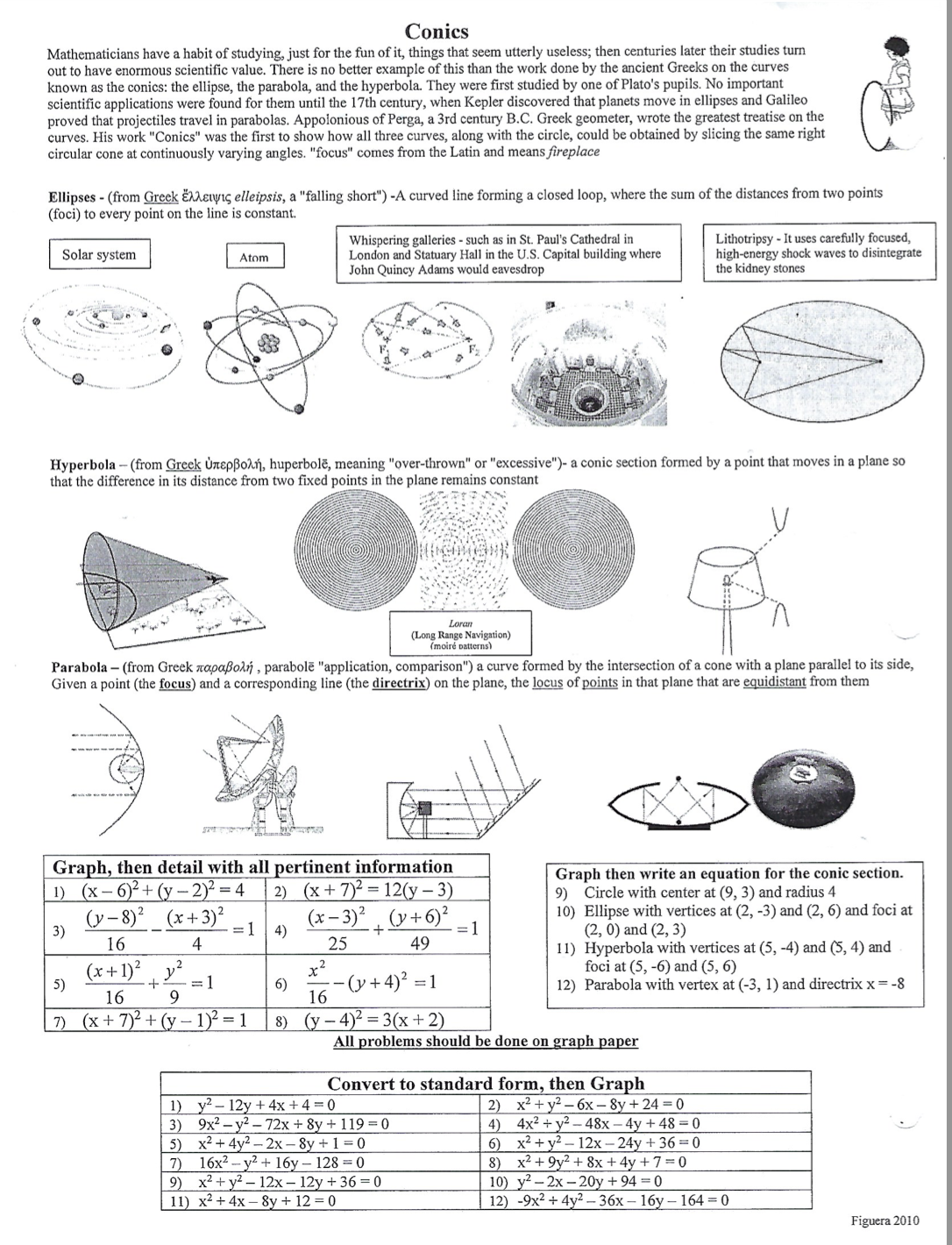Conics Mathematicians have a habit of studying, just for the fun of it, things that seem utterly useless; then centuries later their studies turn out to have enormous scientific value. There is no better example of this than the work done by the ancient Greeks on the curves known as the conics: the ellipse, the parabola, and the hyperbola. They were first studied by one of Plato's pupils. No important scientific applications were found for them until the 17th century, when Kepler discovered that planets move in ellipses and Galileo proved that projectiles travel in parabolas. Appolonious of Perga, a 3rd century B.C. Greek geometer, wrote the greatest treatise on the curves. His work "Conics" was the first to show how all three curves, along with the circle, could be obtained by slicing the same right circular cone at continuously varying angles. "focus" comes from the Latin and means fireplace Ellipses - (from Greek Excus elleipsis, a "falling short") -A curved line forming a closed loop, where the sum of the distances from two points (foci) to every point on the line is constant Whispering galleries - such as in St. Paul's Cathedral in Lithotripsy - It uses carefully focused, Solar system Atom London and Statuary Hall in the U.S. Capital building where high-energy shock waves to disintegrate John Quincy Adams would eavesdrop the kidney stones Hyperbola -(from Greek UnepBorn, huperbole, meaning "over-thrown" or "excessive")- a conic section formed by a point that moves in a plane so that the difference in its distance from two fixed points in the plane remains constant Loran A (Long Range Navigation) (moire patterns) Parabola -(from Greek zapaBorn , parabole "application, comparison") a curve formed by the intersection of a cone with a plane parallel to its side, Given a point (the focus) and a corresponding line (the directrix) on the plane, the locus of points in that plane that are equidistant from them Graph, then detail with all pertinent information Graph then write an equation for the conic section. 1) (x - 6)2+ (y - 2)2 = 4 2) (x + 7)2 = 12(y - 3) 9) Circle with center at (9, 3) and radius 4 3 ) (y - 8) (x+3)2 =1 4 ) (x - 3)2 (1+6)2 10) Ellipse with vertices at (2, -3) and (2, 6) and foci at = 1 4 (2, 0) and (2, 3 16 25 49 1 1) Hyperbola with vertices at (5, -4) and (5, 4) and (x + 1)2 x 2 -(y +4)2 =1 foci at (5, -6) and (5, 6) 5) = 1 16 9 6) 16 12) Parabola with vertex at (-3, 1) and directrix x = -8 7) (x + 7)2+ (y - 1)2 = 1 8) (y - 4)2 = 3(x + 2) All problems should be done on graph paper Convert to standard form, then Graph 1) y2 - 12y + 4x + 4 = 0 2) x-+ y2 - 6x - 8y + 24= 0 3) 9x2 - y2 - 72x + 8y + 119 =0 4) 4x2 + y2 - 48x - 4y + 48 = 0 5) x2 + 4y2 - 2x - 8y + 1=0 6) x2 + y2 - 12x - 24y + 36= 0 16x2 - y2 + 16y - 128 = 0 8) x2 + 9y2 + 8x+4y+7=0 9) x2 + y2 - 12x - 12y + 36 = 0 10) y2 - 2x - 20y + 94 = 0 11) x2 + 4x - 8y + 12 = 0 12) -9x2 + 4y2 - 36x - 16y - 164= 0 Figuera 2010







